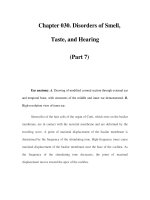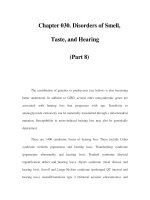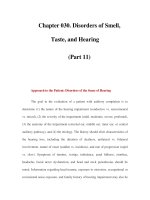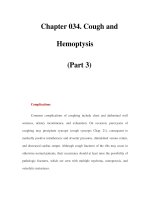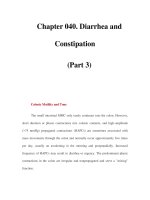Disorders Techniques in Investigation and Diagnosis - part 3 pps
Bạn đang xem bản rút gọn của tài liệu. Xem và tải ngay bản đầy đủ của tài liệu tại đây (579.95 KB, 36 trang )
Figure 3.2
Longitudinal lines in a patient with rheumatoid arthritis.
Figure 3.3
Longitudinal lines—old age ‘sausage link’ appearance.
Modifications of the nail surface 61
Figure 3.4
Longitudinal lines—prominent old age changes, which may occur
earlier with chronic arterial impairment.
Figure 3.5
Longitudinal dystrophy in lichen planus.
A text atlas of nail disorders 62
Figure 3.6
Mild onychorrhexis in lichen planus.
Figure 3.7
(a, b) Severe onychorrhexis and nail thinning in lichen planus.
Modifications of the nail surface 63
Figure 3.8
Longitudinal nail groove due to (a) glomus tumour, (b) myxoid cyst,
(c) fibrokeratoma.
Figure 3.9
Myxoid cyst—longitudinal groove and Beau’s lines.
A text atlas of nail disorders 64
Figure 3.10
Heller’s median canaliform dystrophy (Leclercq’s variant).
Figure 3.11
Heller’s median canaliform dystrophy.
Modifications of the nail surface 65
Figure 3.12
Onychotillomania—median nail dystrophy of several nails.
Figure 3.13
Onychotillomania—severe median nail dystrophy of the thumb and
third finger nail.
Figure 3.14
Central longitudinal grooved dystrophy, self-induced by trauma to the
matrix.
A text atlas of nail disorders 66
Figure 3.15
Unilateral central longitudinal grooved dystrophy.
Figure 3.16
Deep groove plus transverse lines—self-induced matrix trauma.
Longitudinal ridges
Small rectilinear projections extend from the proximal nail fold as far as the free edge o
f
the nail, or they may stop short. They may be interrupted at regular intervals, giving rise
to a beaded appearance. Sometimes a wide, longitudinal median ridge has the
appearance, in cross-section, of a circumflex accent. The condition is inherited an
d
affects mainly the thumb and index fingers of both hands.
Table 3.1 shows the principal causes of longitudinal lines and grooves.
Modifications of the nail surface 67
HERRINGBONE NAILS
The pattern of nail ridging known as ‘herringbone nails’, with oblique lines pointing
centrally to meet in the midline, has been reported as an uncommon phenomenon
occurring in childhood (Figure 3.17). It characteristically disappears as the child grows.
Less obvious, similar lines may be seen associated with the pointed matrix of the nail-
patella syndrome.
TRANSVERSE LINES
Transverse, band-like depressions extending from one lateral edge of the nail to the other,
and affecting all nails at corresponding levels, are called Beau’s lines (Figures 3.18
–
3.22). They may be noted after any severe, sudden (particularly febrile) illness. In milde
r
Table 3.1
Causes of longitudinal lines
Coloured lines
White See leukon
y
chia (pa
g
es 128–134)
Black See melanonychia (pages 134–139)
Red Darie
r
’s disease (see Fi
g
ure 2.55)
Vascular tumours
Glomus (Figure 3.8)
Cirsoid
Linear rid
g
es
Sin
g
le Familial
Median canaliform d
y
stroph
y
(Fi
g
ure 3.10)
Trauma (isolated or repeated)
Tumours
Multiple
N
ormal; increase with a
g
e after earl
y
adulthood (Fi
g
ures 3.1, 3.3, 3.4)
With all causes of thin nail plates
Lichen planus (Fi
g
ure 3.5)
Rheumatoid arthritis
Graft-versus-host disease
Psoriasis
Darie
r
’s disease
Poor circulation
Colla
g
en vascular diseases
Radiation
Frostbite
Alopecia areata
N
ail-
p
atella s
y
ndrome
S
y
stemic am
y
loidosis
A text atlas of nail disorders 68
cases the nails of the thumb and the great toe are the most reliable markers, as the forme
r
supplies information for the previous 6–9 months and the latter shows evidence o
f
disease for up to 2 years (relating to the different rates of linear nail growth).
The width of the transverse groove relates to the duration of the disease that has
affected the matrix. The distal limit of the furrow, if abrupt, indicates a sudden attack o
f
disease; if sloping, a more protracted onset. The proximal limit of the depression may be
abrupt, and both limits may well be sloped. If the the disease can completely inhibit the
activity of the matrix for 1–2 weeks or longer, the transverse depression will result in
total division of the nail plate, a defect known as ‘onychomadesis’ (Figures 3.23, 3.24).
As the nail adheres firmly to the nail bed the onychomadesis remains latent for several
weeks before leading to temporary shedding.
Figure 3.17
(a) Herringbone nail appearance with oblique lines meeting in the
midline—a temporary change of early childhood; (b) nail-patella
syndrome—more subtle, but similar lines to (a); associated with
pointed lunula. (Part (a) from Parry EJ, Morley WN, Dawber RPR
(1995), Herringbone nails: an uncommon variant of nail growth in
childhood? Br J Dermatol
132:
1021–1022.)
T
he presence of Beau’s lines on all 20 nails is usually the result
of systemic disease
Modifications of the nail surface 69
Figure 3.18
Beau’s lines.
Figure 3.19
Beau’s lines—contact dermatitis.
Transverse furrows may be due to measles in childhood, zinc deficiency (often
multiple), Stevens-Johnson and Lyell’s syndromes, cytotoxic drugs and many other non-
specific events. Beau’s lines can also be physiological, e.g. marks appearing with each
menstrual cycle, particularly in dysmenorrhoea. They have also been noted in babies aged
4–5 weeks, without any obvious cause. When only a few digits are involved this may
indicate trauma, carpal tunnel syndrome, chronic paronychia or chronic eczema. If the
lines appear following a chronic condition, they are often numerous and curvilinear.
A text atlas of nail disorders 70
Figure 3.20
Transverse lines due to chemotherapy cycles. (Courtesy of L.Requena.)
Figure 3.21
Beau’s lines in psoriasis.
Figure 3.22
Modifications of the nail surface 71
Long Beau’s line (depression) due to more prolonged arrest of growth.
(Courtesy of J.P.Ortonne, Nice.)
Figure 3.23
Onychomadesis due to bleomycin therapy for warts
on the proximal nail fold.
Figure 3.24
Beau’s lines and onychomadesis due to psoriasis.
Table 3.2
Causes of transverse grooves
Common
Hi
g
h fever
Postnatal
Menstrual c
y
cle (multiple
g
rooves), d
y
smenorrhoea
Measles
Trauma
Chronic paronychia
Local inflammation
Chronic eczema
Uncommon
Kawasaki s
y
ndrome
A text atlas of nail disorders 72
When a series of transverse grooves parallels the proximal nail fold the cause is likely
to be repeated trauma from overzealous manicuring. ‘Rhythmic’
p
arallel transverse
grooves may be an isolated sign of psoriasis, equivalent to patterned pitting.
The nervous habit of pushing back the cuticle usually affects the thumbs which are
damaged by either the thumb nail of the opposite hand or the index finger nail of the
corresponding hand: symmetrical involvement of the thumbs is the rule and damage is
most commonly effected by the thumb nail of the other hand (see Figures 3.14, 3.16).
Occasionally only one thumb is affected; rarely, other digits may be involved, the thumb
reversing roles and creating the damage. This produces:
Table 3.2 lists causes of transverse groove formation.
PITTING AND RIPPLING
Pitting and rippling are also known as pits, onychia punctata, erosions and Rosenau’s
depressions. Pits develop as a result of defective nail formation in punctate areas located
in the proximal portion of the nail matrix. The surface of the nail plate is studded with
small punctate depressions which vary in number, size, depth and shape. The depth and
width of the pits relates to the extent of the matrix involved; their length is determined by
the duration of the matrix damage. Pits result from a defective keratinization of the
p
roximal matrix with persistence of parakeratotic cells in the nail plate surface. These
cells are easily shed, leaving the punctate depression (Figure 3.25). They may be
randomly distributed or uniformly arranged in series along one or several longitudinal
lines; they are sometimes arranged in a criss-cross pattern and may resemble the external
surface of a thimble.
Stevens-Johnson s
y
ndrome
C
y
totoxic dru
g
s
Acrodermatitis enteropathica and zinc deficienc
y
H
y
poparath
y
roidism
S
y
philis
Mouth, hand and foot disease
Radiation
Carpal tunnel syndrome
1
Swelling, redness and scaling of the proximal nail fold from the mechanical injury.
2
Multiple horizontal grooves that do not extend to the lateral margin of the nail; often
filled with debris, they are interspersed between the ridges.
3
A large central longitudinal or slightly lateral depression along the nail mimicking
median canaliform dystrophy, with an enlarged lunula.
Modifications of the nail surface 73
Figure 3.25
Pit formation.
Figure 3.26
Multiple nail pits, arranged in transverse lines.
A text atlas of nail disorders 74
Figure 3.27
Multiple nail pits—similar to Figure 3.26, but more lined in
appearance.
Figure 3.28
Pits in the proximal nail plate are still covered by parakeratotic scales.
It has been shown that regular pitting may convert to rippling or ridging, and these two
conditions appear, at times, to be variants of uniform pitting (Figures 3.26–3.28). Nails
showing diffuse pitting grow faster than the apparently normal nails in psoriasis.
Occasional pits occur on normal nails. Deep pits can be attributed to psoriasis, and
profuse pitting is most often due to this condition (Figures 3.29, 3.30). In alopecia areata
(Figure 3.31) shallow pits are usually seen and they are often numerous, leading to
trachyonychia (rough nail) and twenty-nail dystrophy; however, curiously, one nail often
remains unaffected for a long time, Pits may also occur in eczema or occupational
trauma. In some cases a genetic basis is thought likely. In secondary syphilis and
p
ityriasis rosea pitting occurs rarely. One case of the latter has been observed with the
pits distributed on all the finger nails at corresponding levels, analogous to Beau’s lines.
Table 3.3
Causes of pitting
Common
Psoriasis (Fi
g
ures 3.26, 3.27, 3.29, 3.30)
Alopecia areata (Fi
g
ure 3.31)
Eczema
Occupational trauma
Parakeratosis pustulosa
Uncommon
N
ormal
Pit
y
riasis rosea
Secondar
y
s
y
philis
Modifications of the nail surface 75
Figure 3.29
Multiple nail pits due to psoriasis.
Figure 3.30
Diffuse pitting of the whole nail in psoriasis.
Sarcoidosis
Reite
r
’s s
y
ndrome
Lichen planus
L
arge, deep and irregular pits are common in psoriasis and
eczema
S
mall, superficial and regular pits are typical of alopecia areata
A
n isolated pit is not diagnostic and may be dye to minor
trauma
A text atlas of nail disorders 76
Figure 3.31
Multiple nail pits—‘rippled’ effect in alopecia areata.
Table 3.3 lists the causes of nail pitting.
TRACHYONYCHIA (ROUGH NAILS)
The term ‘twenty-nail dystrophy’ or trachyonychia describes a spectrum of nail plate
surface abnormalities that result in nail roughness (Figures 3.32–3.38). Patients with
trachyonychia can be divided into two main groups:
Figure 3.32
Trachyonychia (rough nails) due to alopecia areata.
1
Trachyonychia and a past history or clinical evidence of alopecia areata.
2
Isolated nail involvement (idiopathic trachyonychia).
Modifications of the nail surface 77
Figure 3.33
Trachyonychia—shiny variety.
Figure 3.34
Trachyonychia—idiopathic.
A text atlas of nail disorders 78
Figure 3.35
Trachyonychia—involvement of a single nail.
Figure 3.36
Trachyonychia in a manual worker.
Figure 3.37
Trachyonychia—lichen planus.
Twenty-nail dystrophy usually occurs sporadically but a few familial and hereditary cases
have been reported. It has occasionally been described in association with ichthyosis
vulgaris and atopic dermatitis, diffuse neuro-dermatitis, vitiligo, dark red lunulae and
knuckle pads, selective immunoglobulin A (IgA) deficiency, autoimmune
thrombocytopenic purpura and haemolytic anaemia.
Modifications of the nail surface 79
Figure 3.38
Trachyonychia—twenty-nail dystrophy of lichen planus.
All these associations, however, should be considered coincidental.
Trachyonychia is typically associated with severe alopecia areata of children.
According to the authors’ data trachyonychia is observed in 12% of children and 3.3% o
f
adults with alopecia areata. The frequency of this condition is closely related to the
severity of the disease; it is more frequent in males than in females, with a male to female
ratio of 4:1.
The onset and course of the nail changes are not strictly related to the onset and course
of alopecia areata, and nail abnormalities in some patients may appear months or even
years before the onset of hair loss. Some consider trachyonychia to be a negative
p
rognostic factor for alopecia areata. It should, however, be noted that trachyonychia is
typical of children with alopecia universalis who usually have a poor prognosis. When
the outcome of treatment of alopecia areata is evaluated according to age and disease
severity, the
presence or absence of trachyonychia is not important for the prognosis.
The frequency of idiopathic trachyonychia is unknown, although it is certainly rare,
more commonly but not exclusively seen in children. Idiopathic trachyonychia may be a
clinical manifestation of several nail diseases including lichen planus, psoriasis, eczema
and pemphigus vulgaris. It may also represent a clinical variety of alopecia areata limited
to the nails. Two clinical varieties of trachyonychia have been described: opaque
trachyonychia (Figure 3.35) and shiny trachyonychia (Figure 3.33). Both these varieties
may occur in association with alopecia areata or may be idiopathic. Opaque
trachyonychia is more common than the shiny type.
In opaque trachyonychia the nail plate surface shows severe longitudinal ridging and is
covered by multiple adherent small scales. The nail is thin, opaque, lustreless and gives
I
diopathic tranchyonychia of childhood is a bening condition
that usually returns entirely to normal
A text atlas of nail disorders 80
the impression of having been sandpapered in a longitudinal direction (vertically striated
sandpapered nails). The cuticle of the affected nails is ragged and some degree o
f
koilonychia is often present. In shiny trachyonychia the nail plate surface abnormalities
are less severe. Nail plate roughness is mild and caused by a myriad of minuscule
p
unctate depressions, which give the nail plate surface a shiny appearance. In some
p
atients a proportion of the nails have the sandpapered appearance while others have the
shiny appearance. Trachyonychia is symptomless and patients complain of only
brittleness and cosmetic discomfort.
Although trachyonychia is better known as twenty-nail dystrophy, the nail changes do
not necessarily involve all nails in every patient (Figure 3.35). It is a symptom that may
b
e caused by several inflammatory diseases that disturb nail matrix keratinization. There
is no clinical criterion that enables one to distinguish spongiotic trachyonychia, the most
common type, from trachyonychia due to other inflammatory skin diseases such as lichen
p
lanus, psoriasis, eczema or pemphigus vulgaris. Trachyonychia is a benign condition
that never produces nail scarring. This is true not only for trachyonychia associated with
spongiotic changes, but also for trachyonychia due to lichen planus or othe
r
dermatological disease. Spongiotic trachyonychia regresses spontaneously in a few years
in most patients.
The association with vitiligo is a consequence of the frequent association of vitiligo
with alopecia areata. Idiopathic trachyonychia can in fact be due to alopecia areata
limited to the nails. This also explains why trachyonychia may occur in families and
occasionally affects identical twins. The close link between trachyonychia
and alopecia areata makes it common to observe trachyonychia in other conditions
frequently associated with alopecia areata, such as atopic dermatitis, ichthyosis o
r
Down’s syndrome.
Table 3.4 lists the known causes and associations of trachyonychia.
T
he only condition that is frequently associated with
trachyoychia and should be searshed for in all cases is alopecia
areata
Table 3.4
Causes and associations of trachyonychia
Idiopathic (twent
y
-nail d
y
stroph
y
) (Fi
g
ure 3.34)
Alopecia areata (Fi
g
ure 3.32)
Lichen planus (Figures 3.37, 3.38)
Eczematous histolo
gy
Chemicals
Modifications of the nail surface 81
ONYCHOSCHIZIA (LAMELLAR SPLITTING)
In onychoschizia, the distal portion of the nail splits horizontally. The nail is formed in
layers (somewhat analogous to plywood) in a similar manner to the formation of scales in
the epidermis (Figure 3.39). Various exogenous factors may contribute to the defect. It is
common in people whose work involves repeated soaking of the hands in water, typically
in housework, leading to frequent hydration and dehydration of the nails. Onychoschizia
Figure 3.39
Onychoschizia (lamellar splitting or layering).
Figure 3.41
Onychoschizia and onychorrhexis due to lichen planus.
‘
Layering’ in the diastal portion of the finger nail is usually due
to frequent wetting
A text atlas of nail disorders 82
Figure 3.40
Onychoschizia lamellina affecting several finger nails.
Figure 3.42
Onychoschizia and onychorrhexis due to systemic amyloidosis.
has been reported in X-linked dominant chondrodysplasia punctata and in polycythaemia
vera. It may be seen in the proximal portion of the nail in lichen planus (Figure 3.41), and
also as a result of oral retinoid therapy (Figures 3.43, 3.44).
The term ‘elkonyxis’ indicates proximal onychoschizia that is especially seen in
patients taking oral retinoids.
Table 3.5 lists the known causes of onychoschizia.
Modifications of the nail surface 83
Figure 3.43
Onychoschizia due to oral retinoid therapy.
Figure 3.44
Proximal onychoschizia due to oral retinoid therapy.
A text atlas of nail disorders 84
Figure 3.45
Superficial nail fragility due to nail lacquer.
FURTHER READING
Herringbone nails
Parry EJ,
Morley WN,
Dawber RPR
(1995) Herringbone nails: an uncommon varian
t
of nail growth in childhood? Br J Dermatol
132:
1021–1022.
Trachyonychia
Baran R,
Dawber RPR
(1987) Twenty nail dystrophy of childhood: a misnamed
syndrome, Cutis
39:
481–482.
Tosti A,
Fanti PA,
Morelli R,
Bardazzi F
(1991) Trachyonychia associated with
alopecia areata: a clinical and pathological study, J Am Acad Dermatol
25:
266–270.
Tosti A,
Bardazzi F,
Piraccini BM,
Fanti PA
(1994) Trachyonychia (twenty nail
dystrophy): clinical and pathological study of 23 patients, Br J Dermatol
131:
866–872.
Onychoschizia
Table 3.5
Causes of onychoschizia (lamellar splitting)
Proximal
Distal
Psoriasis Chemical in
j
ur
y
Lichen planus (Fi
g
ure 3.41) Old a
g
e
Retinoid therapy (Figure 3.43) Repeated wetting
Chondrod
y
splasia punctata of the nails (X-linked)
Pol
y
c
y
thaemia vera
Modifications of the nail surface 85


